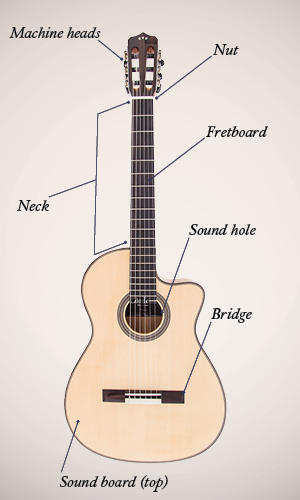Care and Maintenance
How to care for your
Acoustic Guitar
Assembly

- Take the instrument out of its case or off the stand and check that all strings are in tune.
- If present, check that the guitar's strap buttons are secure and tight.
Note: If going to a gig or rehearsal with other musicians, check that all the fretted notes that you will be playing are properly notated and also check for the tone.
Note: Be sure you have necessary picks and other accessories. It is best practice to carry a backup set of the strings you use in case a string breaks.
After Use Care
- Wipe down strings and body with cotton cloth to help strings/finish last longer.
- Remove the shoulder strap (if present) and store it in your case.
- Place the instrument back into case or onto the stand.
Optional: Throw the pick to the crowd or place back in your case.
Regular Maintenance
- During the winter and summer the instrument’s neck may need a truss rod adjustment due to the wood in the neck shrinking or expanding.
- In climates where humidity drops below 40%, wood can shrink and cause cracks in the finish or wood. Instrument humidifiers are easy to install and serve as a solution to prevent such problems.
- Some woods (Rosewood, Ebony, etc.) that are used for the fingerboard have a tight grain and therefore many times finish is not needed to keep the wood stable. These woods do dry out over time and can benefit in appearance and lifetime by applying a light fingerboard oil (lemon oil, snake oil, bore oil, mineral oil, etc.) when the instrument is restrung and the fingerboard is more accessible. Please check with a technician before purchasing or applying any oil that you are unfamiliar with.
- When restringing your instrument, it is important to remember the following:
- Check the bridge pins and replace any that are overly worn to ensure that the strings are secure on the guitar.
- Check for overly worn frets to avoid buzzing noises and in order to keep good intonation on your instrument.
- Check your tuning mechanisms as they can loosen overtime. Be careful not to tighten the screws holding the paddles too tightly as this can impede the mechanics of the paddles.
Electric Guitar
Assembly

- Take the instrument out of its case or off the stand and check that all six strings are in tune. Attach strap if desired. If going to a gig or rehearsal with other musicians, check that all the fretted notes that you will be playing are properly notated and also check for the tone.
- If present, check that the guitar's strap buttons are secure and tight.
- Check all electronics and cable(s) for proper function.
Note: Be sure you have necessary picks and other accessories. It is best practice to carry a backup set of the strings you use in case a string breaks.
After Care Use
- Wipe down strings and body with cotton cloth to help strings/finish last longer.
- Remove the shoulder strap (if present) and store it in your case.
- Place the instrument back into the case or on to the stand.
Optional: Throw the pick to the crowd or place back in your case.
Regular Maintenance
- During the winter and summer the instrument may need a truss rod adjustment due to the wood in the neck shrinking or expanding.
- In climates where humidity drops below 40%, wood can shrink and cause cracks in the finish or wood. Instrument humidifiers are easy to install and serve as a solution to prevent such problems.
- Some woods (Rosewood, Ebony, etc.) that are used for the fingerboard have a tight grain and therefore many times finish is not needed to keep the wood stable. These woods do dry out over time and can benefit in appearance and lifetime by applying a light fingerboard oil (lemon oil, snake oil, bore oil, mineral oil, etc.) when the instrument is restrung and the fingerboard is more accessible. Please check with a technician before purchasing or applying any oil that you are unfamiliar with.
- When restringing your instrument, it is important to remember the following:
- Check the bridge pins and replace any that are overly worn to ensure that the strings are secure on the guitar.
- Check for overly worn frets to avoid buzzing noises and in order to keep good intonation on your instrument.
- Check your tuning mechanisms as they can loosen overtime. Be careful not to tighten the screws holding the paddles too tightly as this can impede the mechanics of the paddles.
- Electronics can wear over time and can cause noise or lack of function of the instrument. If the potentiometers, jacks, or switches are accessible, contact cleaner can be used to clean these components. If the components still do not function, they may need replacing.
